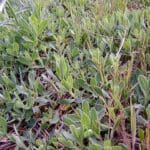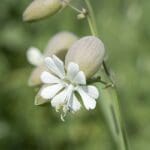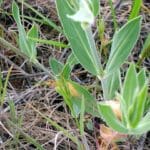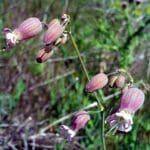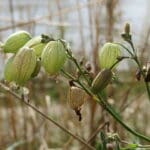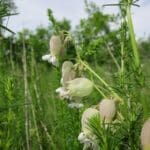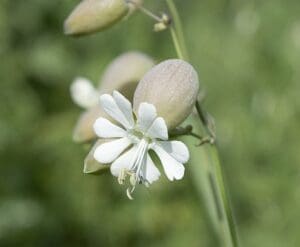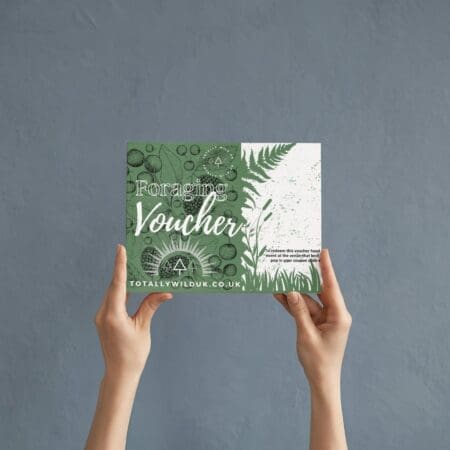Bladder Campion / Summer / Autumn / Edible
Young leaves of Bladder Campion have a sweet flavour like a combination of honey and peas. Use in salads, blanch or steam or stir fry briefly.
Common Names
Bladder Campion, Maidenstears
Botanical Name
Silene vulgaris
Scientific Clasification
Kingdom – Plantae
Order – Caryphyllales
Family – Caryophylllaceae
Physical Charectaristics of Bladder Campion
An upright, hairless or sometimes pubescent perennial, up to 90cm high.
Leaves
Leaves are waxy, grey and hairless, quite rubbery to touch; oval, ending in a point with a distinct midrib; stalk-less, except for the basal leaves, in opposite pairs, with each successive pair rotated at right angles to the previous one.
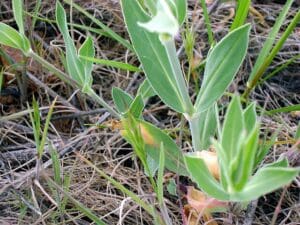
Flowers
The flowers are white, 10-18cm in diameter, with five notched/forked petals and a pale or pink, ribbed and swollen, bladder-like calyx tube. The calyx tube is veined with 20 main veins, narrowing at the apex and ending in upright teeth. The flowers tend to droop. The calyx tube becomes a distinctive bladder-shaped seed-pod that remains visible well into the winter. The presence of seed-pods helps to identify where the flowers will grow the following year.
Habitat
Found throughout Europe and the British Isles except for high altitudes.
Prefers loose soils in open/partially shaded places such as hedgerows, open woodland, cultivated fields, walls, quarries, gravel pits, disturbed ground on dry calcareous soils.
Known Hazards
Although no mention of toxicity has been seen for this species, it does contain saponins. Although toxic, these substances are very poorly absorbed by the body and so tend to pass through without causing harm. They are also broken down by thorough cooking. Saponins are found in many plants, including several that are often used for food, such as certain beans. It is advisable not to eat large quantities of food that contain saponins.
Could be Confused with
Can be confused with White Campion (Silene latifolia). White Campion is more hairy than the Bladder Campion, its flowers are larger (25-30mm in diameter) and its calyx is less swollen.
Sea Campion (Silene uniflora) has similar leaves to Bladder Campion but it is a prostrate maritime perennial with a cushion of non-flowering shoots. Its flowers are larger than Bladder Campion (20-25cm). The calyx doesn’t narrow at the apex as seen in Bladder Campion and the teeth of the bladder are recurved rather than the erect teeth seen in the Bladder Campion.
Edible Uses
Young leaves have a sweet flavour like a combination of honey and peas. Use in salads, blanch or steam, or stir fry briefly. Older leaves are rather bitter but less so when cooked.
Basal leaves are most worthwhile, being easier to pick in quantity and sweeter than later leaves.
In Crete the plant is called Agriopapoula and the locals eat its leaves and tender shoots browned in olive oil. It is widely eaten in Cyprus and in recent years has been cultivated and sold in shops in bunches. In Italy the leaves may be used as an ingredient in risotto and the leaves are valued as a green vegetable, for example in a chickpea and Silene vulgaris stew called Potaje de garbanzos y collejas (Collejas being the bladder campion leaves).
Notes on Herbal uses
It has been used in traditional medicine for a variety of ailments, including coughs, colds, and respiratory problems. The plant’s leaves and stems contain compounds that have been found to have antimicrobial and anti-inflammatory properties.
Extra notes from the Foragers
It is one of the main food plants of the Frog-hopper insects which are known for surrounding themselves with a protective froth while feeding. The froth is often known as Cuckoo Spit.
References
http://www.wildflowerweb.co.uk/plant/86/bladder-campion



